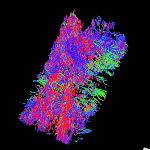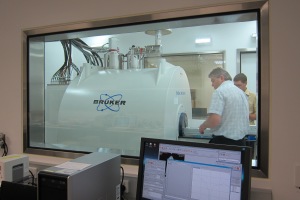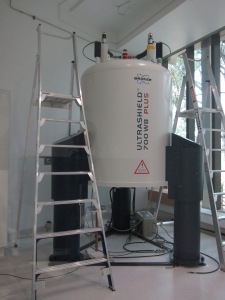The primary research focus of our group is investigating the use of diffusion weighted magnetic resonance imaging (DWI) for detection and characterization of cancer, especially in prostate and breast tissue.
DWI of Prostate Tissue

Smooth muscle fibre tractography of a 3mm diameter core of normal prostate tissue. Data from a 40 micrometer isotropic 16.4T DTI scan. The central void corresponds to the location of a gland acinus.
The current best practice for anatomical assessment of prostate cancer is multiparametric MRI (mpMRI) which combines T2, dynamic contrast enhanced (DCE) MRI, and DWI . mpMRI is increasingly being used for tumour localization to assist targeted biopsy, risk stratification, and treatment selection. Nevertheless, mpMRI requires further improvement before it can be confidently used to plan nerve-sparing surgery or focal radiation therapy.
DWI is the most reliable component of the mpMRI exam, even though the protocols currently in use are remarkably unsophisticated. The DWI signal correlates strongly with prostate cancer Gleason grade, and provides a better estimate of gold-standard histopathology prostate cancer volume than other imaging modalities.
Despite the immature method development, the superior cancer detection performance of DWI can be attributed to its direct sensitivity to the changes in microscopic tissue architecture that are used to diagnose the presence and grade of cancer.
Our groundbreaking DWI research has defined the diffusion properties of prostate tissue at an unprecedented spatial resolution approaching the cellular scale, and has resolved several clinical imaging controversies. This research also shows how major improvements can be achieved by increasing the tissue information content of current DWI methods.
Collaborators
We work with several groups in Australia and around the world. The University of New South Wales Biological Resources Imaging Laboratory (BRIL) has a 9.4 Tesla MRI scanner on which we perform our whole-organ MRI studies.
The University of Queensland (UQ) has a 16.4 T MR spectrometer which allows us to resolve prostate tissue samples at 40 micron isotropic voxel resolution.
Prof. Bill Price and the Nanoscale Organisation and Dynamics Group at the University of Western Sydney.
Prof. Daniel Alexander, Dr. Laura Panagiotaki, Dr. Matt Hall and others in the Microstructure Imaging Group at University College London (UCL) who make the diffusion simulation and analysis software, Camino.
Prof. Uwe Himmelreich and the Molecular Small Animal Imaging Centre (moSAIC) at KU Leuven in Belgium

